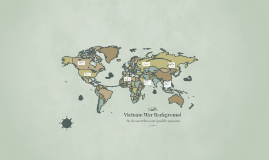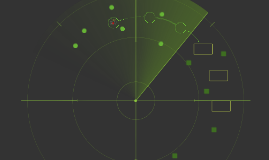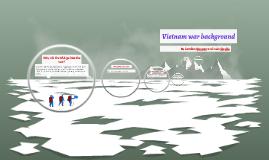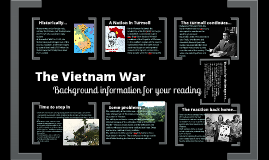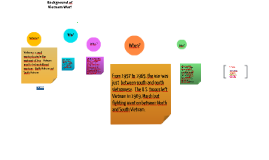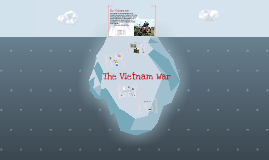Vietnam Background
Transcript: The Vietnam War End of the War The War at Home Former pentagon employee leaks documents to the New York TimesRevealed:Government officials questioned the war privately while publicly supporting it Decisions were being made without consent of congressThe public was being deceived about the situation in Vietnam Chemical Warfare My Lai Massacre(March 1968):An American platoon massacred possibly more than 200 unarmed South Vietnamese civilians in My LaiVictims were women, children, and old men LBJ leaves presidential race and Nixon wins(1969)Nixon cuts back the number of troops in Vietnam North Vietnam and South Vietnam were being “ruled” by two opposing forcesThe Vietcong, a guerilla army, grew stronger and more powerful because of their terror tacticsThe constant redrawing of alliances and the constant political shift confused people Everyone wanted a piece of Vietnam U.S. Conflicted Context Immense antiwar movement Internal conflict: country, families, and generations still dividedIncreased immorality: drugs, STDs, post traumatic stress disorder Numbers to Know U.S. Involvement “…he would explain to her why he had let himself go to the war. Not because of strong convictions, but because he didn’t know. He didn’t know who was right, or what was right; he didn’t know if it was a war of self-determination or self-destruction, outright aggression or national liberation; he didn’t know which speeches to believe, which books, which politicians; he didn’t know if nations would topple like dominoes or stand separate like trees; he didn’t know who really started the war, or how, or when, or with what motives; he didn’t know if it mattered; he saw sense in both sides of the debate, but he did not know where truth lay.[…] He wasn’t stupid. He was uninformed. He just didn’t know if the war was right or wrong or somewhere in the murky middle. And who did?” -Tim O’Brien, Going After Cacciato Draft: selection for required military service At the beginning of the war, a college student was exempt from the draft Some professors gave their students A's just to keep them out of the war Minorities dominated death toll Draft increased, putting students at risk Students publicly burned their draft cards and evaded the draft in Canada Could not return to U.S. until official pardon in 1977 About 1/3 of the US soldiers who fought in Vietnam were drafted Conflict in Vietnam Increases U.S. Joins the War "No event in American history is more misunderstood than the Vietnam War. It was misreported then, and it is misremembered now. Rarely have so many people been so wrong about so much. Never have the consequences of their misunderstanding been so tragic." -- President Richard Nixon The War in Vietnam Napalm: jellied gasoline that explodes on contact dropped from American planes Agent Orange: A chemical that strips the trees and shrubs turning farmland and forest into wastelands VC guerilla tactics: sudden unexpected attacks carried out by an unofficial military group or groups trying to change the government by assaults on armed forces VC blended in with the general population Americans had firepower and arms Americans used search and destroy missions to find enemy troops, bomb their positions, destroy their supply lines and force them into the open Americans sought to destroy the landscape Armistice Opposed to Imperialism Did NOT want France to take Vietnam Opposed to Communism Did NOT want Communist Party to take Vietnam Nixon admin conducted the Christmas bombings using b-52s for 12 days pausing only on Christmas Two sides met and agreed to end fighting and return prisoners after the war (1975) War lasted almost 8 years--longest war in US history Presidential Switch Anti-communism sentiment U.S. feared the Domino Effect Thought to protect U.S. from communism Wanted to unify North and South Vietnam U.S. troops sent into Vietnam From Tim O’Brien (notice syntax ;] ) Ho Chi Minh Operation Rolling Thunder Effect on American Society The Draft Japan surrendered control of Vietnam in 1945 Ho Chi Minh announced Vietnam was an independent nationFrance wanted to regain their colonial empire and troops returned in 1946 driving Vietminh forces into hiding Vietminh (Minh’s forces) fought the French and increased control over large areas of countryside Fighting escalated & French requested help from the US The Pentagon Papers Conflict over Control Bombing of Ho Chi Minh Trail Trail was difficult to see because of the thick jungleOver 1000 trails and pathsUS started to bomb it and wiped out supply line from Vietminh to Viet CongUsed a wide variety of technology and intelligence to penetrate the trail American Deaths: 58,220Average age of US soldier: 23 years oldYoungest US solider to die in Vietnam 16 years old (even though draft age was 18)Claimed 5+ million Southeast Asian lives Vietcong vs. U.S. Troops Born in 1890 in Vietnam Studied in Soviet Union where he became an advocate for communism Returned to Vietnam in 1930 and founded Communist Party






